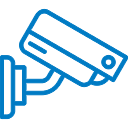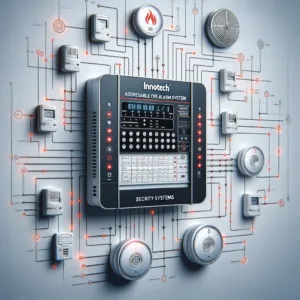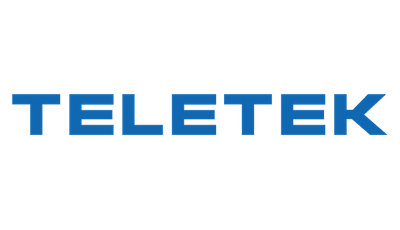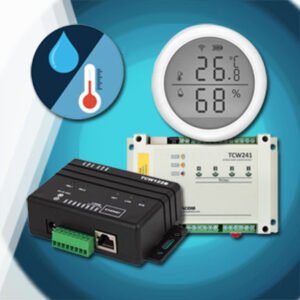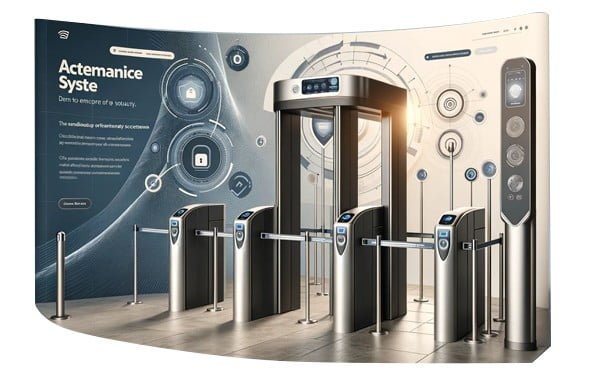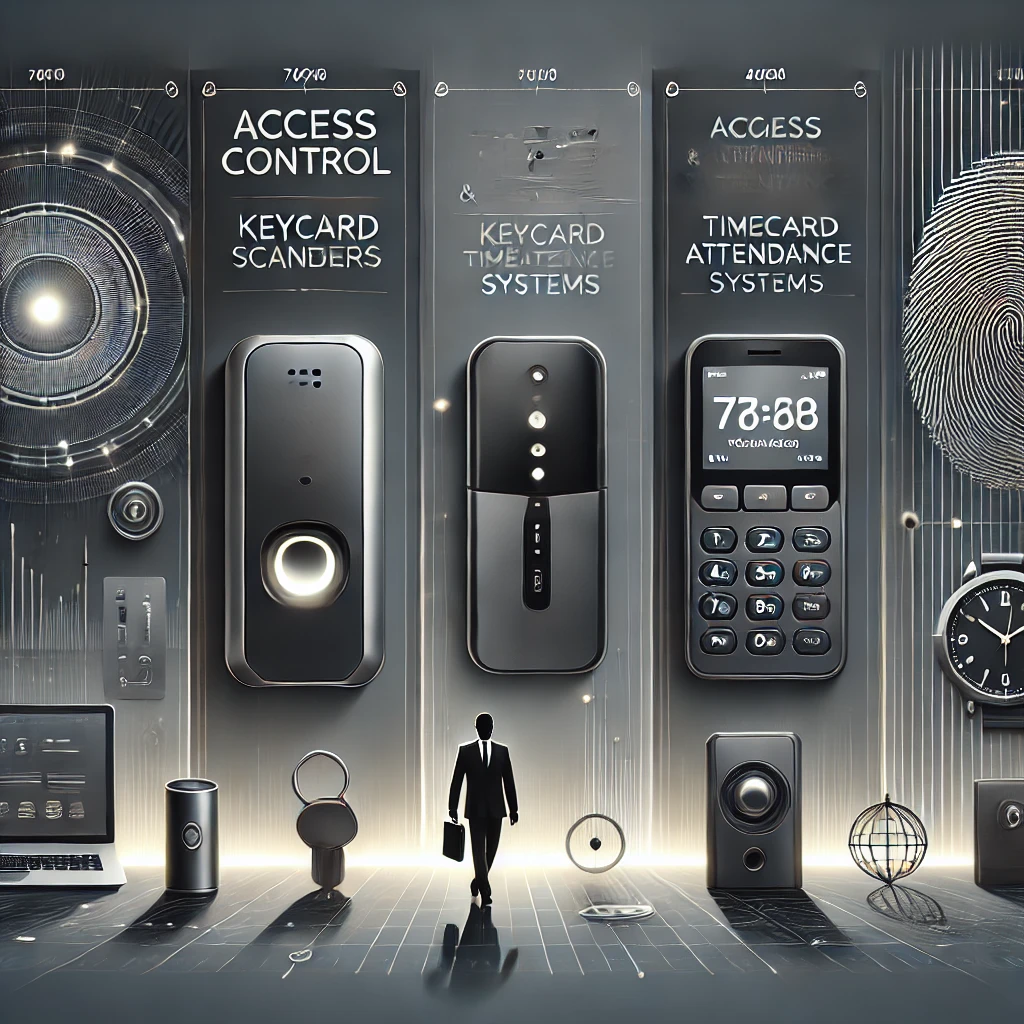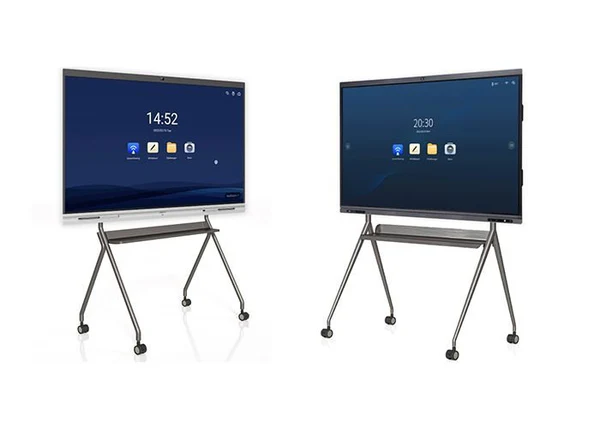ყველაფერი რაც თქვენ უნდა იცოდეთ ელექტრო დაშვების კონტროლის სისტემებისა და დასწრების აღრიცხის ფუნქციონალურობის შესახებ

ელექტრული წვდომის კონტროლის სისტემების შესავალი
ელექტრული წვდომის კონტროლის სისტემები წარმოადგენს მნიშვნელოვან წინსვლას უსაფრთხოების სისტემების სფეროში, გვთავაზობს მძლავრ მექანიზმებს სხვადასხვა შენობებზე წვდომის კონტროლისა და მონიტორინგისთვის. ფუნდამენტურად, ეს სისტემები იყენებს ელექტრონულ მოწყობილობებს წვდომის ნებართვების სამართავად, რაც უზრუნველყოფს, რომ მხოლოდ უფლებამოსილ პირებს შეუძლიათ შევიდნენ კონკრეტულ ადგილებში. ეს მიიღწევა ნიშნების, პაროლების, ბიომეტრიული მონაცემების ან სმარტ ბარათების ინტეგრაციის გზით, რომლებიც ემსახურება როგორც უსაფრთხო შესვლის სერთიფიკატს.
ელექტრული წვდომის კონტროლის სისტემების ფუნქციონირება დამოკიდებულია მათ უნარზე, გააკონტროლონ შესვლები და გასვლები რეალურ დროში, ჩაწერონ წვდომის მცდელობები და უზრუნველყონ დეტალური ჟურნალები მომავალი მითითებისთვის. წვდომის მართვის პროცესის ავტომატიზაციით, ეს სისტემები აძლიერებენ უსაფრთხოებას და ასევე აუმჯობესებენ ოპერაციულ ეფექტურობას. კორპორატიულ გარემოში, სადაც მგრძნობიარე ინფორმაცია და ღირებული აქტივები უნდა იყოს დაცული, ასეთი სისტემები შეუცვლელია. ანალოგიურად, საცხოვრებელი კორპუსები სარგებლობენ ამ სისტემების მოხერხებულობითა და გაზრდილი უსაფრთხოებისგან, რადგან ისინი გამორიცხავს ტრადიციული გასაღებების აუცილებლობას, რომელთა დაკარგვა ან დუბლირება შესაძლებელია.
ელექტრული წვდომის კონტროლის სისტემები სასიცოცხლოდ მნიშვნელოვანია დღევანდელ უსაფრთხოების ლანდშაფტში მათი საიმედოობისა და მოქნილობის გამო. ისინი უზრუნველყოფენ უსაფრთხოების მრავალი მახასიათებლის უწყვეტი ინტეგრაციის საშუალებას, როგორიცაა სათვალთვალო კამერები და განგაშის სისტემები, რაც ქმნის უსაფრთხოების ყოვლისმომცველ გადაწყვეტას. Innotech-მა, ლიდერმა უსაფრთხოების სისტემების სფეროში, გამოიყენა ეს ტექნოლოგია უახლესი გადაწყვეტილებების უზრუნველსაყოფად, რომლებიც აკმაყოფილებს როგორც კორპორატიულ, ასევე საცხოვრებელ საჭიროებებს. წვდომის კონტროლის მოწინავე სისტემების გამოყენებით, ორგანიზაციებს შეუძლიათ უზრუნველყონ მათი შენობების უსაფრთხოება, ხოლო მაცხოვრებლებს შეუძლიათ ისარგებლონ სიმშვიდით, რადგან იციან, რომ მათი სახლები დაცულია.
მათი ფართო გამოყენების გათვალისწინებით, ელექტრო წვდომის კონტროლის სისტემების მნიშვნელობა უსაფრთხო და ეფექტური ოპერაციების შესანარჩუნებლად არ შეიძლება გადაჭარბებული იყოს. ტექნოლოგიის განვითარებასთან ერთად, ეს სისტემები ასევე სულ უფრო დახვეწილია, გვთავაზობს მეტ ფუნქციებს და უფრო მარტივ გამოყენებას. ეს მათ აქცევს უსაფრთხოების თანამედროვე პრაქტიკის ქვაკუთხედს, ადგენს სტანდარტს, თუ როგორ იმართება წვდომა და დროზე დასწრება სხვადასხვა სექტორში.
ელექტრო წვდომის კონტროლის სისტემები და დროზე დასწრების სისტემები იყენებს იდენტიფიკაციის სხვადასხვა მეთოდს უსაფრთხოების გასაძლიერებლად და შესვლის პროცესების გასაუმჯობესებლად. იდენტიფიკაციის ყველაზე გავრცელებულ მეთოდებს შორის არის საკვანძო ბარათები, ბიომეტრია, PIN კოდები და მობილურზე დაფუძნებული იდენტიფიკაცია. თითოეული მეთოდი გთავაზობთ მკაფიო უპირატესობებსა და პოტენციურ ნაკლოვანებებს უსაფრთხოების, გამოყენების სიმარტივისა და ღირებულების თვალსაზრისით.
გასაღები ბარათები
საკვანძო ბარათები ფართოდ გამოიყენება წვდომის კონტროლის სისტემებში მათი მარტივი გამოყენებისა და შედარებით დაბალი ღირებულების გამო. წვდომის მისაღებად მომხმარებლებს შეუძლიათ უბრალოდ გადაფურცლეს ან შეეხონ საკვანძო ბარათებს. თუმცა, მიუხედავად იმისა, რომ საკვანძო ბარათები იძლევა მოსახერხებელ გადაწყვეტას, ისინი მიდრეკილნი არიან ქურდობის ან დაკარგვის მიმართ, რაც იწვევს უსაფრთხოების შეშფოთებას. გარდა ამისა, საკვანძო ბარათების გაცემასა და შეცვლასთან დაკავშირებული ხარჯები შეიძლება დროთა განმავლობაში დაგროვდეს.
ბიომეტრია
ბიომეტრიული იდენტიფიკაციის მეთოდები, მათ შორის თითის ანაბეჭდი, სახის ამოცნობა და ბადურის სკანირება, სულ უფრო გავრცელებულია თანამედროვე უსაფრთხოების სისტემებში, როგორიცაა Innotech. უნიკალური ფიზიოლოგიური მახასიათებლების გამოყენებით, ბიომეტრიული სისტემები გვთავაზობენ უსაფრთხოების უფრო მაღალ დონეს საკვანძო ბარათებთან შედარებით. მაგალითად, თითის ანაბეჭდების და ბადურის სკანირების გამეორება თითქმის შეუძლებელია, რაც ამცირებს არაავტორიზებული წვდომის რისკს. თუმცა, ბიომეტრიული სისტემების დანერგვა შეიძლება უფრო ძვირი დაჯდეს მოწინავე ტექნოლოგიების გამო. უფრო მეტიც, ზოგიერთ მომხმარებელს შეუძლია ბიომეტრიული სისტემები ნაკლებად მოსახერხებელი აღმოაჩინოს, განსაკუთრებით იმ შემთხვევაში, თუ ისინი საჭიროებენ ზუსტ პოზიციონირებას ან თუ გარემო ფაქტორები გავლენას ახდენს მათ ფუნქციონირებაზე.
PIN კოდები
PIN კოდები უზრუნველყოფს წვდომის კონტროლის მარტივ და ეკონომიურ მეთოდს. მომხმარებლებმა უნდა შეიყვანონ რიცხვითი კოდი წვდომის მისაღებად. ამ მეთოდის მთავარი უპირატესობა მისი სიმარტივე და დაბალი ღირებულებაა, რადგან არ არის საჭირო ფიზიკური ბარათები ან მოწინავე ტექნოლოგია. მიუხედავად ამისა, PIN კოდების ადვილად გაზიარება ან დავიწყება შესაძლებელია, რაც საფრთხეს უქმნის უსაფრთხოებას. გარდა ამისა, ეფექტურობის შესანარჩუნებლად აუცილებელია PIN-ების რეგულარული განახლება და მართვა.
მობილურზე დაფუძნებული იდენტიფიკაცია
მობილურზე დაფუძნებული იდენტიფიკაცია არის განვითარებადი ტენდენცია წვდომის კონტროლის სისტემებში, სმარტფონების და სხვა მობილური მოწყობილობების გამოყენებაში. მომხმარებლებს შეუძლიათ დაცულ ადგილებში წვდომა აპების, Bluetooth ან NFC ტექნოლოგიის მეშვეობით. ეს მეთოდი აერთიანებს მოხერხებულობას უსაფრთხოების გაძლიერებულ ფუნქციებთან, როგორიცაა მრავალფაქტორიანი ავთენტიფიკაცია. მობილურზე დაფუძნებულ იდენტიფიკაციას შეუძლია შეამციროს ოპერაციული ხარჯები, რომლებიც დაკავშირებულია ფიზიკურ ბარათებთან და PIN-ის მენეჯმენტთან. თუმცა, უსაფრთხოება შეიძლება იყოს შეშფოთებული, თუ მობილური მოწყობილობები დაიკარგება ან დაზიანებულია. გარდა ამისა, თავდაპირველი დაყენების ღირებულება და მობილურ მოწყობილობებზე დამოკიდებულება შესაძლოა გამოწვევას შეუქმნას ზოგიერთი მომხმარებლისთვის.
მოკლედ, არჩევანი საკვანძო ბარათებს, ბიომეტრიულ მონაცემებს, PIN კოდებსა და მობილურზე დაფუძნებულ იდენტიფიკაციას შორის დამოკიდებულია უსაფრთხოების სპეციფიკურ საჭიროებებზე, გამოყენების მარტივობაზე და ბიუჯეტის შეზღუდვებზე. თითოეული მეთოდი იძლევა უნიკალურ უპირატესობებს, რაც გადამწყვეტს ხდის ორგანიზაციებს შეაფასონ თავიანთი სპეციფიკური მოთხოვნები წვდომის კონტროლის სისტემის არჩევისას.
დროში დასწრების ფუნქციონირების ინტეგრირება
ელექტრო წვდომის კონტროლის სისტემები არ არის მხოლოდ იმის მართვა, თუ ვის შეუძლია შესვლა ან გასვლა კონკრეტულ შენობაში; ისინი ხშირად აერთიანებენ დროში დასწრების ფუნქციებს, რომლებიც გადამწყვეტ როლს თამაშობენ თანამედროვე სამუშაო ადგილებზე. ამ შესაძლებლობების ინტეგრირებით, ასეთი სისტემები იძლევა ყოვლისმომცველ გადაწყვეტას თანამშრომლების სამუშაო საათების თვალყურის დევნებისთვის, რითაც გაზრდის პროდუქტიულობას და უზრუნველყოფს სახელფასო სიზუსტეს.
წვდომის კონტროლის სისტემებში დროის დასწრების მახასიათებლების ინტეგრირების ერთ-ერთი მთავარი უპირატესობა არის თანამშრომლების შესვლისა და გასვლის დროების ავტომატურად დოკუმენტირების შესაძლებლობა. ეს არა მხოლოდ გამორიცხავს სახელმძღვანელო შეცდომებს, არამედ აუმჯობესებს დასწრების თვალთვალის პროცესს. ასეთი სისტემების დანერგვა უზრუნველყოფს ზუსტი ჩანაწერების შენარჩუნებას ძალისხმევის გარეშე, რაც აუცილებელია ხელფასების გაანგარიშებისა და შრომის კანონმდებლებთან შესაბამისობისთვის.
სიზუსტის გარდა, დროში დასწრების ფუნქციების ინტეგრირება მნიშვნელოვნად ზრდის პროდუქტიულობას. ეს სისტემები გვთავაზობენ რეალურ დროში ცნობებს სამუშაო ძალის მენეჯმენტზე, რაც დამსაქმებლებს საშუალებას აძლევს დააკვირდნენ დასწრების შაბლონებს, დაადგინონ დაგვიანება ან სწრაფად აღმოაჩინონ უჩვეულო არყოფნა. ეს საშუალებას იძლევა დროული ინტერვენციები, გააუმჯობესოს პერსონალის მთლიანი პროდუქტიულობა და ოპერატიული ეფექტურობა.
ფართომასშტაბიანი ოპერაციების მქონე ინდუსტრიები დიდ სარგებელს იღებენ ამ ინტეგრაციისგან. მაგალითად, საწარმოო ქარხნები, რომლებიც ხშირად მუშაობენ ცვლაზე დაფუძნებული გრაფიკით, ეყრდნობიან მძლავრ ინოტექნიკურ უსაფრთხოების სისტემებს, რათა უზრუნველყონ ცვლაების ზუსტი მონიტორინგი. ანალოგიურად, ჯანდაცვის სექტორი იყენებს ამ სისტემებს, რათა მართოს პერსონალის რთული როტაცია და უზრუნველყოს ჯანდაცვის მუშაკების ზუსტი კომპენსაცია მათი საათებისთვის. საცალო ვაჭრობის ინდუსტრიებში, დროის დასწრების სისტემები ხელს უწყობს პერსონალის ოპტიმალური დონის შენარჩუნებას პიკის საათებში და ეფექტურად მართოს ზეგანაკვეთური სამუშაოები.
უფრო მეტიც, საგანმანათლებლო დაწესებულებები და კორპორატიული ოფისები უზარმაზარ მნიშვნელობას პოულობენ ასეთ სისტემებში. სკოლებს შეუძლიათ გაამარტივონ მასწავლებელთა დროის აღრიცხვა და უზრუნველყონ მოსწავლეთა უსაფრთხოება ზუსტი დაშვების კონტროლის მეშვეობით. მეორეს მხრივ, კორპორატიული ოფისები სარგებლობენ სამუშაო ძალის გამარტივებული მენეჯმენტით, გამარტივებული ადმინისტრაციული ამოცანებით და დისტანციური სამუშაო საათების ზუსტად თვალყურის დევნების შესაძლებლობით.
დასასრულს, დროში დასწრების ფუნქციების ინტეგრაცია ელექტრო წვდომის კონტროლის სისტემებში წარმოადგენს ერთიან გადაწყვეტას, რომელიც არა მხოლოდ უზრუნველყოფს უსაფრთხოებას, არამედ ზრდის პროდუქტიულობას და სიზუსტეს თანამშრომლების მენეჯმენტში. ეს სისტემები ფასდაუდებელია სხვადასხვა ინდუსტრიებში, რაც ხელს უწყობს ოპერაციულ ეფექტურობას და საიმედო დასწრების თვალყურის დევნებას.
მონაცემთა უსაფრთხოების უზრუნველყოფა წვდომის კონტროლის სისტემებში
მონაცემთა უსაფრთხოება არის ფოკუსის კრიტიკული სფერო ელექტრული წვდომის კონტროლის სისტემების სფეროში. ვინაიდან ორგანიზაციები სულ უფრო მეტად ეყრდნობიან ამ სისტემებს თავიანთი შენობებისა და აქტივების დასაცავად, წვდომასთან დაკავშირებული მონაცემების მთლიანობისა და კონფიდენციალურობის უზრუნველყოფა უმნიშვნელოვანესი ხდება. ამ სისტემებში თავდაცვის პირველი ხაზი დაშიფვრაზეა ორიენტირებული. დაშიფვრის ძლიერი პროტოკოლების დანერგვა უზრუნველყოფს, რომ წვდომის წერტილებსა და საკონტროლო სისტემებს შორის გადაცემული მონაცემები დაცული დარჩეს თვალთვალისა და არაავტორიზებული წვდომისგან. დაშიფვრის სტანდარტები, როგორიცაა AES (დაშიფვრის გაფართოებული სტანდარტი) გადამწყვეტ როლს თამაშობს პოტენციური დარღვევების აღკვეთაში, რის შედეგადაც მონაცემები გაუგებარი ხდება მავნე აქტორებისთვის.
დაშიფვრის მიღმა, მონაცემთა შენახვის უსაფრთხო გადაწყვეტილებები წარმოადგენს კიდევ ერთ მნიშვნელოვან კომპონენტს წვდომის კონტროლის სისტემების დაცვაში. მოვლენებთან წვდომასთან დაკავშირებული მონაცემები, მომხმარებლის რწმუნებათა სიგელები და სისტემის კონფიგურაციები უნდა განთავსდეს უსაფრთხო გარემოში, ხშირად მაღალი უსაფრთხოების სერვერების ან ღრუბელზე დაფუძნებული ინფრასტრუქტურის გამოყენებით უსაფრთხოების მოწინავე ზომებით. შენახვის ეს გადაწყვეტილებები ხშირად მოიცავს მექანიზმებს, როგორიცაა მრავალფაქტორიანი ავთენტიფიკაცია და როლებზე დაფუძნებული წვდომის კონტროლი, რათა უზრუნველყოფილი იყოს მხოლოდ ავტორიზებულ პერსონალს შეუძლია სენსიტიური ინფორმაციის წვდომა. გარდა ამისა, მონაცემთა ჭარბი რაოდენობა და რეგულარული სარეზერვო ასლები გამოიყენება მონაცემთა დაკარგვის ან კორუფციის რისკის შესამცირებლად.
საუკეთესო პრაქტიკის დანერგვა განუყოფელია წვდომის კონტროლის სისტემებში უსაფრთხოების მაღალი დონის შესანარჩუნებლად. პროგრამული უზრუნველყოფის რეგულარულად განახლება და შესწორება ფუნდამენტური პრაქტიკაა მოწყვლადობის აღმოსაფხვრელად და განვითარებადი საფრთხეებისგან თავის დასაცავად. უსაფრთხოების საფუძვლიანი აუდიტისა და დაუცველობის შეფასების ჩატარება ხელს უწყობს პოტენციური სისუსტეების იდენტიფიცირებას და გამოსწორებას. გარდა ამისა, მომხმარებლის განათლებისა და ტრენინგის პროგრამების გამოყენება აძლიერებს პერსონალის ინფორმირებულობას და პასუხისმგებლობას უსაფრთხოების პოტენციურ ინციდენტებზე, რაც კიდევ უფრო აძლიერებს სისტემის მთლიან უსაფრთხოების პოზას.
Innotech Security Systems არის ინდუსტრიის ლიდერის მაგალითი, რომელიც ვალდებულია მონაცემთა უსაფრთხოების ინტეგრირება მოახდინოს მათ წვდომის კონტროლისა და დროის დასწრების სისტემებში. უახლესი ტექნოლოგიების გამოყენებით და უსაფრთხოების ყოვლისმომცველი პრაქტიკის დაცვით, Innotech უზრუნველყოფს, რომ მათი გადაწყვეტილებები არა მხოლოდ აკმაყოფილებდეს, არამედ აღემატება უსაფრთხოების მკაცრ მოთხოვნებს, რომლებიც მოითხოვენ თანამედროვე ორგანიზაციებს. მონაცემთა უსაფრთხოებისადმი ასეთი ერთგულება უზრუნველყოფს, რომ როგორც წვდომის კონტროლი, ასევე დროზე დასწრების ფუნქციები ფუნქციონირებს შეუფერხებლად და უსაფრთხოდ მათი განლაგების განმავლობაში.
კანონთან და რეგულაციებთან შესაბამისობა
ელექტრო წვდომის კონტროლის სისტემებისა და დროის დასწრების სისტემების გამოყენება მოითხოვს მრავალი კანონისა და რეგულაციის მკაცრ დაცვას, რომლებიც მიზნად ისახავს მონაცემთა უსაფრთხოებისა და პირადი კონფიდენციალურობის უზრუნველყოფას. ამ სისტემების დანერგვა არ არის მხოლოდ ტექნოლოგიური განახლება, არამედ სამართლებრივი ვალდებულება, რომელიც იცავს ბიზნესს პოტენციური სამართლებრივი და ფინანსური შედეგებისგან. ორი გლობალურად აღიარებული სტანდარტი, მონაცემთა დაცვის ზოგადი რეგულაცია (GDPR) ევროპაში და კალიფორნიის მომხმარებელთა კონფიდენციალურობის აქტი (CCPA), წარმოადგენს მკაცრი მარეგულირებელი ჩარჩოების თვალსაჩინო მაგალითებს, რომლებიც არეგულირებს დაშვების კონტროლის მექანიზმების გამოყენებას.
GDPR აწესებს ყოვლისმომცველ მოთხოვნებს ევროკავშირის (EU) ფარგლებში მოქმედი ან ევროკავშირის რეზიდენტების მონაცემებთან დაკავშირებული ორგანიზაციებისთვის. ის მოითხოვს მონაცემთა დამუშავების მკაცრ პროტოკოლებს, ხაზს უსვამს პერსონალური მონაცემების დაცვას, რომელიც მოიცავს ნებისმიერ ინფორმაციას, რომელიც დაკავშირებულია იდენტიფიცირებულ ან იდენტიფიცირებულ პირთან. წვდომის კონტროლის სისტემებისა და დროის დასწრების ფუნქციონალურობის კონტექსტში, ბიზნესებმა უნდა უზრუნველყონ შეგროვებული მონაცემების დამუშავება კანონიერად, გამჭვირვალედ და ლეგიტიმური მიზნებისთვის. შესაბამისობა გულისხმობს უსაფრთხოების მძლავრი ზომების განხორციელებას არაავტორიზებული წვდომის თავიდან ასაცილებლად და მონაცემთა ნებისმიერი დარღვევის დროული აღმოფხვრის მიზნით. GDPR-ის მნიშვნელობა სცილდება შესაბამისობას; ეს აძლიერებს მომხმარებელთა ნდობას და აძლიერებს ორგანიზაციის რეპუტაციას ევროკავშირის ბაზარზე.
ანალოგიურად, CCPA ადგენს მკაცრ სახელმძღვანელო მითითებებს კალიფორნიაში მოქმედი ბიზნესებისთვის, რომლებიც ფოკუსირებულია მომხმარებელთა კონფიდენციალურობის უფლებებისა და მონაცემთა დაცვაზე. CCPA ანიჭებს მომხმარებლებს უფლებას იცოდნენ შეგროვებული პერსონალური მონაცემების, მისი მიზნისა და ვის შესახებ არის გამჟღავნებული. კომპანიებისთვის, რომლებიც იყენებენ წვდომის კონტროლის სისტემებს, ეს ნიშნავს მონაცემთა შეგროვების პრაქტიკის გამჭვირვალედ კომუნიკაციას და მონაცემთა შემცირების პრინციპების დაცვას. უფრო მეტიც, ორგანიზაციებმა უნდა უზრუნველყონ მომხმარებელთათვის მექანიზმები, რომ მოითხოვონ მათი პერსონალური მონაცემების წაშლა, რაც განამტკიცებს მონაცემთა მართვის მნიშვნელობას.
ამ რეგულაციებთან შესაბამისობა ხაზს უსვამს წვდომის კონტროლის სისტემების მნიშვნელოვან როლს სენსიტიური მონაცემების დაცვაში და ამავდროულად იცავს ორგანიზაციების იურიდიულ და ეთიკურ ვალდებულებებს. ბიზნესები, რომლებიც იყენებენ უსაფრთხოების ინოვაციურ სისტემებს, როგორიცაა Innotech-ის მიერ მოწოდებული, უნდა იყვნენ ფხიზლად და ადაპტირებულნი იყვნენ განვითარებად მარეგულირებელ ლანდშაფტთან, რათა ხელი შეუწყონ უსაფრთხო და შესაბამის ოპერაციულ გარემოს.
მომხმარებლის კონფიდენციალურობისა და პერსონალური მონაცემების უსაფრთხოების დაცვა
პერსონალური მონაცემების დაცვა წვდომის კონტროლის სისტემებში უმნიშვნელოვანესია დღევანდელ ციფრულ ეპოქაში. მოწინავე უსაფრთხოების სისტემების გამოჩენა, როგორიცაა ინოტექ-ის მიერ შემოთავაზებული სისტემა, მოითხოვს მომხმარებლის ინფორმაციის დაცვის ურყევ ვალდებულებას. მნიშვნელოვანია, რომ ასეთი სისტემები იყოს შექმნილი ისე, რომ პერსონალური მონაცემები კონფიდენციალური დარჩეს და ხელმისაწვდომი იყოს მხოლოდ ავტორიზებული პერსონალისთვის.
ამის მისაღწევად ერთ-ერთი ფუნდამენტური ღონისძიება არის დაშიფვრის ძლიერი ტექნიკის საშუალებით. წვდომის კონტროლის სისტემებმა უნდა გამოიყენონ ძლიერი დაშიფვრის ალგორითმები მონაცემების დასაცავად დასვენებისა და ტრანზიტის დროს. ეს ამცირებს არასანქცირებული წვდომის რისკს და უზრუნველყოფს, რომ მომხმარებლის ინფორმაციის გაშიფვრა შეუძლებელია მაშინაც კი, თუ ის ჩართულია.
კიდევ ერთი მნიშვნელოვანი პრაქტიკა არის დაშვების კონტროლის მკაცრი პოლიტიკის განხორციელება. ეს სისტემები ისე უნდა იყოს კონფიგურირებული, რომ მხოლოდ შემოწმებულ და უფლებამოსილ პერსონალს ჰქონდეს წვდომა სენსიტიურ მონაცემებზე. როლებზე დაფუძნებული წვდომის კონტროლი (RBAC) არის ეფექტური მეთოდი იმის დასადგენად, თუ ვის შეუძლია პერსონალური ინფორმაციის ნახვა ან შეცვლა ორგანიზაციაში მათი პოზიციისა და პასუხისმგებლობის მიხედვით.
ასევე აუცილებელია პერიოდული აუდიტი და კონფიდენციალურობის პოლიტიკის განახლებები. კონფიდენციალურობის პროტოკოლების რეგულარულად განხილვა და გადახედვა უზრუნველყოფს მათ შესაბამისობას განვითარებულ საკანონმდებლო მოთხოვნებთან და ინდუსტრიის საუკეთესო პრაქტიკასთან. პოლიტიკის მენეჯმენტის პროაქტიული მიდგომის გამოყენება ხელს უწყობს პოტენციური მოწყვლადობის აღმოფხვრას, სანამ ისინი გამოიყენებენ.
უფრო მეტიც, მონაცემთა ანონიმიზაცია, სადაც ეს შესაძლებელია, საუკეთესო პრაქტიკაა მომხმარებლის კონფიდენციალურობის შესანარჩუნებლად. ეს გულისხმობს პერსონალური იდენტიფიკატორების ამოღებას ან დაბინდვას მონაცემთა ნაკრებიდან, რათა თავიდან აიცილოს პიროვნების იდენტიფიკაცია. მაგალითად, დროში დასწრების სისტემებში, ანონიმური მონაცემები კვლავ შეიძლება გამოყენებულ იქნას ანალიზისა და მოხსენების მიზნებისთვის, პერსონალური ინფორმაციის კომპრომისის გარეშე.
გარდა ამისა, მომხმარებლების განათლება კონფიდენციალურობისა და მონაცემთა უსაფრთხოების პოლიტიკის შესახებ ხელს უწყობს ინფორმირებულობისა და სიფხიზლის კულტურას. სასწავლო პროგრამებმა ხაზი უნდა გაუსვას უსაფრთხოების პროტოკოლების დაცვას და პოტენციური საფრთხეების ამოცნობას. ეს კოლექტიური პასუხისმგებლობა ხელს უწყობს ამ სისტემების საერთო უსაფრთხოების გაძლიერებას.
მომხმარებლის კონფიდენციალურობისა და პერსონალური მონაცემების უსაფრთხოების დაცვა არის მუდმივი პროცესი, რომელიც მოითხოვს მუდმივ ყურადღებას და გაძლიერებას. ამ საუკეთესო პრაქტიკის დანერგვით, ორგანიზაციებს შეუძლიათ უზრუნველყონ, რომ მათი წვდომის კონტროლის სისტემები და დროზე დასწრების სისტემები იცავენ მონაცემთა უსაფრთხოებისა და კონფიდენციალურობის დაცვის უმაღლეს სტანდარტებს.
ელექტრული წვდომის კონტროლის სისტემების უპირატესობები
ელექტრო წვდომის კონტროლის სისტემები გთავაზობთ უამრავ უპირატესობას, რაც მათ შეუცვლელს ხდის თანამედროვე საწარმოებისა და დაწესებულებებისთვის. ერთ-ერთი ყველაზე მნიშვნელოვანი უპირატესობა არის უსაფრთხოების გაძლიერება. ტრადიციული საკეტების დახვეწილი ელექტრონული კონტროლით ჩანაცვლებით, ორგანიზაციებს შეუძლიათ შეზღუდონ წვდომა მგრძნობიარე უბნებზე, უზრუნველყონ მხოლოდ ავტორიზებული პერსონალის შესვლა. ეს გაძლიერებული უსაფრთხოება მნიშვნელოვანია არაავტორიზებული წვდომის თავიდან ასაცილებლად და ისეთი რისკების შესამცირებლად, როგორიცაა ქურდობა და ვანდალიზმი. ისეთ დაწესებულებებში, როგორიცაა საავადმყოფოები და სამთავრობო შენობები, წვდომის კონტროლის სისტემები ხელს უწყობს მგრძნობიარე ინფორმაციისა და აქტივების დაცვას.
კიდევ ერთი მნიშვნელოვანი უპირატესობა არის მასშტაბურობა. როგორც ორგანიზაციები იზრდება, მათი უსაფრთხოების საჭიროებები ვითარდება. ელექტრული წვდომის კონტროლის სისტემები უაღრესად მასშტაბირებადია, რაც იძლევა ახალი მომხმარებლებისა და წვდომის წერტილების შეუფერხებლად დამატებას ძირითადი ინფრასტრუქტურული ცვლილებების გარეშე. მაგალითად, ინოტექი – უსაფრთხოების სისტემები გთავაზობთ გადაწყვეტილებებს, რომლებიც ადვილად შეიძლება გაფართოვდეს თანამშრომლების მზარდი რაოდენობის ან ახალი დაწესებულებების ზონების მოსათავსებლად, რაც უზრუნველყოფს უწყვეტ, საიმედო დაცვას ორგანიზაციის მასშტაბებით.
ამ სისტემების მიერ მოწოდებული მართვის სიმარტივე არ შეიძლება შეფასდეს. ცენტრალიზებული მართვის პროგრამული უზრუნველყოფის საშუალებით, ადმინისტრატორებს შეუძლიათ ერთი ინტერფეისიდან წვდომის წერტილების მონიტორინგი და კონტროლი. ეს შესაძლებლობა ამარტივებს წვდომის დონის დიფერენცირებას და წვდომის ნებართვების დაგეგმვას, რაც აუმჯობესებს უსაფრთხოების მართვის მთლიან პროცესს. მაგალითად, დროში დასწრების სისტემების მართვა წვდომის კონტროლთან ერთად შეიძლება უპრობლემოდ იყოს ინტეგრირებული, რათა ზუსტად აკონტროლოთ თანამშრომლების საათები უსაფრთხოების პროტოკოლების შენარჩუნებისას.
სხვა სისტემებთან ინტეგრაცია ელექტრული წვდომის კონტროლის სისტემების უმთავრესი უპირატესობაა. ეს სისტემები შეიძლება შეუფერხებლად იყოს ინტეგრირებული დროის დასწრების სისტემებთან, ხანძარსაწინააღმდეგო სიგნალიზაციასთან და შენობის მართვის სისტემებთან, რაც ქმნის შეკრული უსაფრთხოების გარემოს. ამით ორგანიზაციებს შეუძლიათ უზრუნველყონ ყოვლისმომცველი დაცვა და ოპერატიული ეფექტურობა. ამ შემთხვევაში, საგანმანათლებლო დაწესებულებამ გამოიყენა უსაფრთხოების ინტეგრირებული სისტემები კამპუსზე წვდომისა და საგანგებო სიტუაციების მართვის ეფექტიანად. ამ ინტეგრაციამ არა მხოლოდ გააძლიერა უსაფრთხოება, არამედ გააუმჯობესა საერთო ოპერაციული სამუშაო პროცესი.
არსებითად, ელექტრული წვდომის კონტროლის სისტემების გამოყენებას მოაქვს უსაფრთხოების მრავალმხრივი მიდგომა, რაც საშუალებას აძლევს ორგანიზაციებს შეინარჩუნონ უსაფრთხოების მაღალი სტანდარტები, მიაღწიონ მასშტაბურობას, მართონ წვდომა ძალისხმევის გარეშე და შეუფერხებლად ინტეგრირდნენ სხვა კრიტიკულ სისტემებთან. რეალურ სამყაროში არსებული აპლიკაციები ხაზს უსვამს პრაქტიკულ უპირატესობებს, რაც უზრუნველყოფს როგორც უსაფრთხოებას, ასევე ოპერაციულ ეფექტურობას.
წვდომის კონტროლის სისტემების მომავალი ტენდენციები
წვდომის კონტროლის სისტემების მომავალზე მნიშვნელოვანი გავლენა იქნება განვითარებადი ტექნოლოგიების მიღწევებით, როგორიცაა ნივთების ინტერნეტი (IoT), ხელოვნური ინტელექტი (AI) და ბლოკჩეინი. ამ ტექნოლოგიებს აქვს პოტენციალი, მოახდინოს რევოლუცია, თუ როგორ აღვიქვამთ და ვახორციელებთ უსაფრთხოებისა და დროის დასწრების სისტემებს.
IoT სავარაუდოდ ითამაშებს გადამწყვეტ როლს, რადგან ის აკავშირებს უამრავ მოწყობილობასა და სისტემას, რაც უზრუნველყოფს უწყვეტ კომუნიკაციას და დისტანციურ მართვას. IoT-ის საშუალებით წვდომის კონტროლის სისტემებს შეუძლიათ ინტეგრირება უსაფრთხოების სხვა სისტემებთან, როგორიცაა სათვალთვალო კამერები და სიგნალიზაცია, რაც უზრუნველყოფს უსაფრთხოების ყოვლისმომცველ გადაწყვეტას. ეს კავშირი საშუალებას იძლევა რეალურ დროში მონიტორინგს და სწრაფ რეაგირებას უსაფრთხოების დარღვევებზე, რაც აძლიერებს უსაფრთხოების მთლიან ინფრასტრუქტურას.
AI არის კიდევ ერთი ინოვაციური ტექნოლოგია, რომელიც შექმნილია წვდომის კონტროლის სისტემების გარდაქმნისთვის. მანქანათმცოდნეობის ალგორითმების მეშვეობით AI-ს შეუძლია გააანალიზოს ქცევის ნიმუშები და აღმოაჩინოს ანომალიები, რითაც თავიდან აიცილოს უსაფრთხოების პოტენციური საფრთხეები. ეს არა მხოლოდ აძლიერებს უსაფრთხოების მახასიათებლებს, არამედ ამატებს მომხმარებლის მოხერხებულობის ფენას. მაგალითად, AI-ს შეუძლია ხელი შეუწყოს უფრო ინტუიციური მომხმარებლის ინტერფეისების განვითარებას და უსაფრთხოების ინფრასტრუქტურის პროგნოზირებად შენარჩუნებას, რაც უზრუნველყოფს სისტემების ეფექტურად მუშაობას მინიმალური შეფერხებით.
ბლოკჩეინის ტექნოლოგია პერსპექტიულ პერსპექტივებს გვთავაზობს მონაცემთა მენეჯმენტსა და უსაფრთხოებაში. მისი დეცენტრალიზებული ბუნება უზრუნველყოფს მონაცემების გაყალბებასა და გამჭვირვალობას, რაც გადამწყვეტია წვდომის კონტროლის სისტემების მიერ დამუშავებული მგრძნობიარე ინფორმაციისთვის. ბლოკჩეინის გამოყენებით, ორგანიზაციებს შეუძლიათ უზრუნველყონ უსაფრთხო, შემოწმებადი და აუდიტორული წვდომის ჟურნალები, რაც ამცირებს არაავტორიზებული წვდომის და მონაცემთა დარღვევის რისკს.
წვდომის კონტროლის სისტემებში მომავალი გაუმჯობესებები, სავარაუდოდ, პრიორიტეტს მიანიჭებს არა მხოლოდ უსაფრთხოებას, არამედ მომხმარებლის კომფორტს. მოსალოდნელია, რომ ბიომეტრიული ავთენტიფიკაცია, მობილური წვდომის სერთიფიკატები და პერსონალურ მოწყობილობებთან ინტეგრაცია უფრო გავრცელებული გახდება. ეს ფუნქციები ამატებს უსაფრთხოების ფენებს მომხმარებლის გამოცდილების გამარტივებაში, რაც წვდომის კონტროლს უფრო უსაფრთხოს და ხელმისაწვდომს ხდის.
მოკლედ, IoT, AI და blockchain-ის ინოვაციური გამოყენება ჩამოაყალიბებს წვდომის კონტროლის სისტემების მომავალს, უზრუნველყოფს უსაფრთხოების ფუნქციების გაუმჯობესებას, მომხმარებლის მოხერხებულობას და მონაცემთა მართვას. კომპანიები, როგორიცაა ინოტექი, წინა პლანზე არიან ამ ტექნოლოგიების დანერგვაში, რაც უზრუნველყოფს, რომ უსაფრთხოების სისტემების მომავალი იყოს ძლიერი და მოსახერხებელი.
